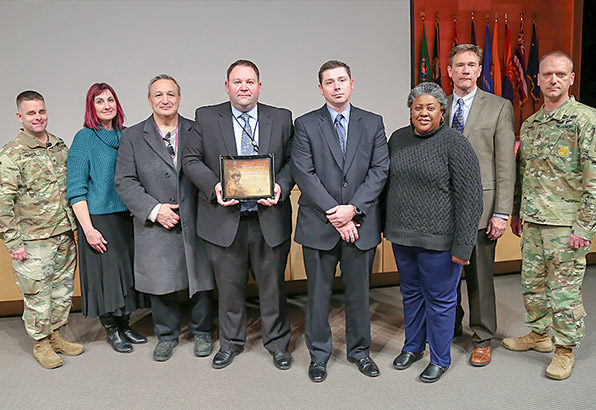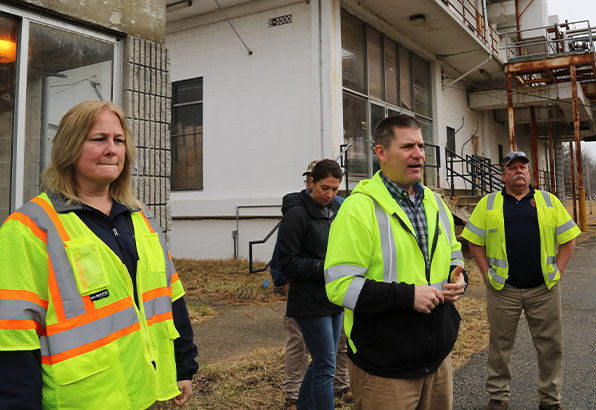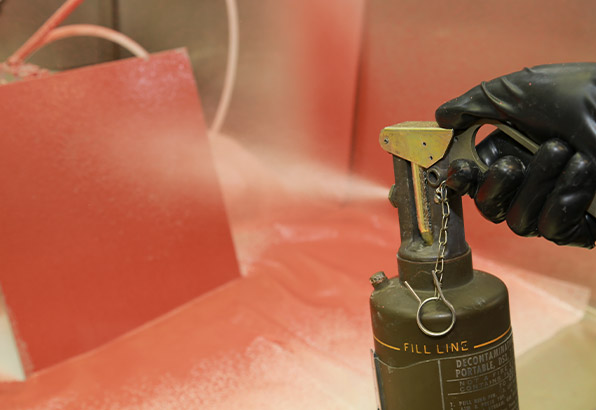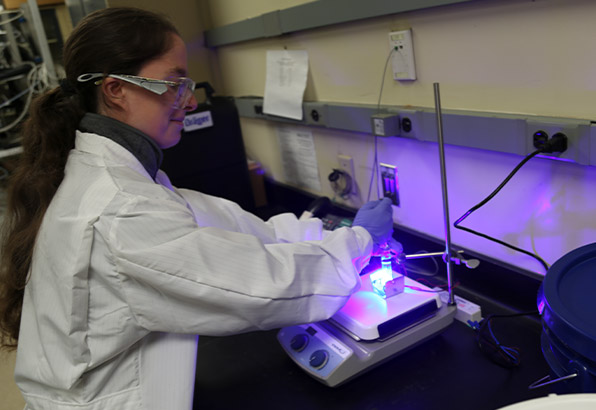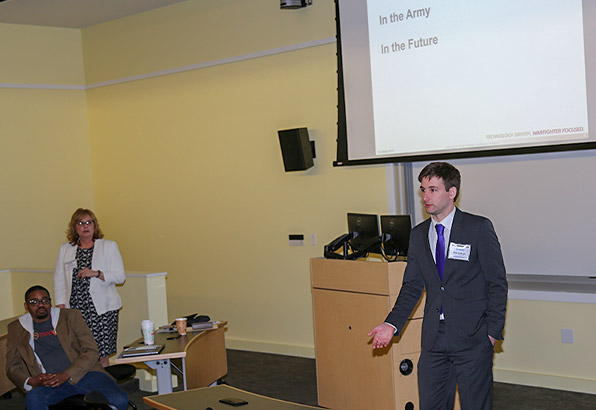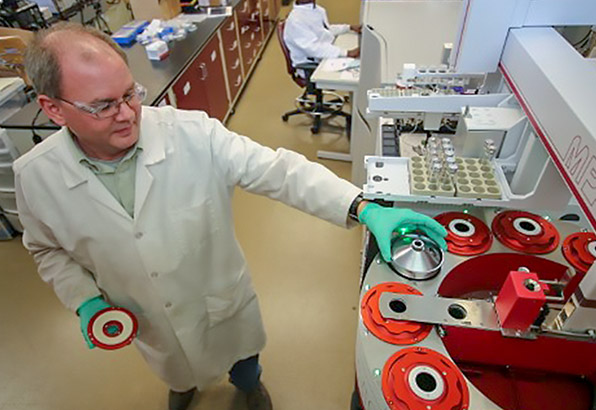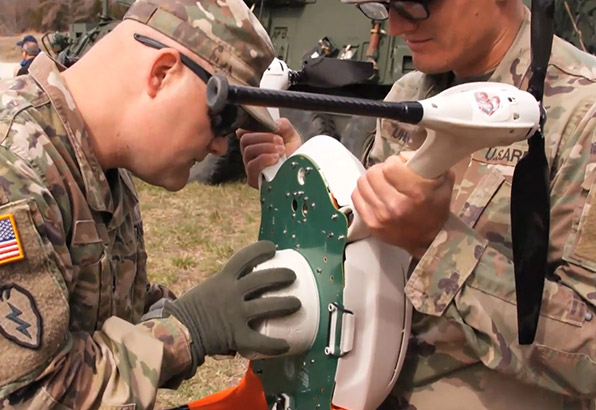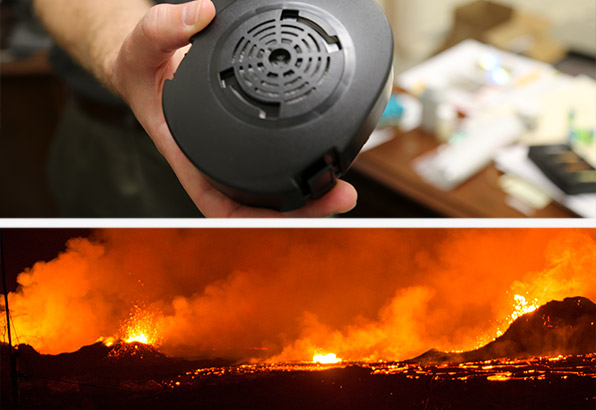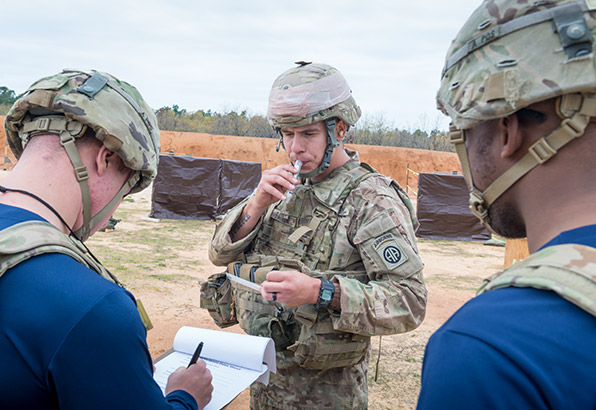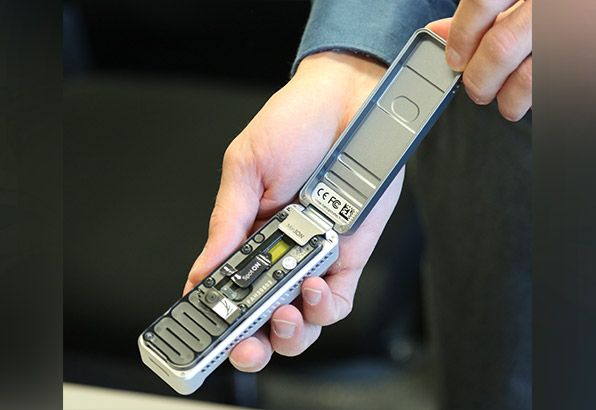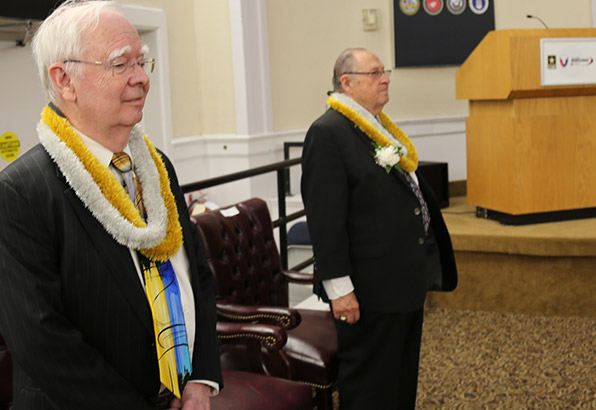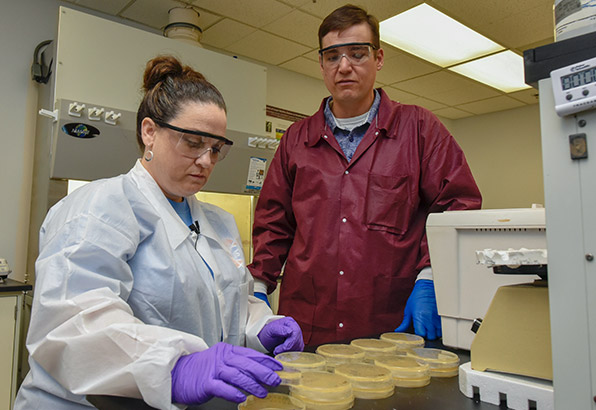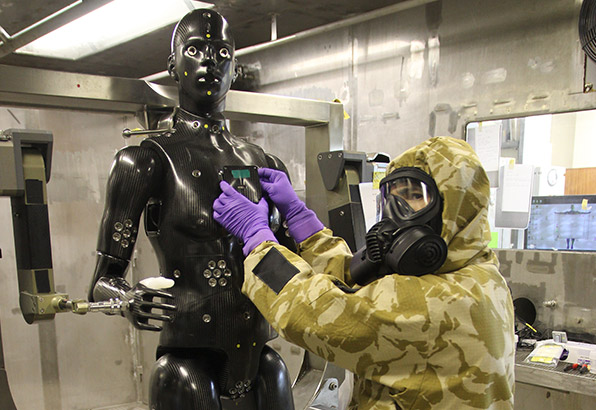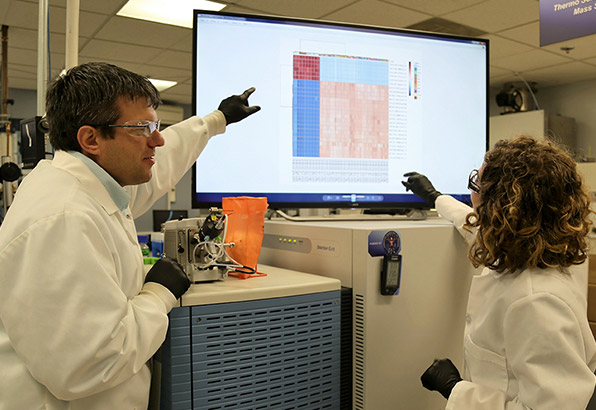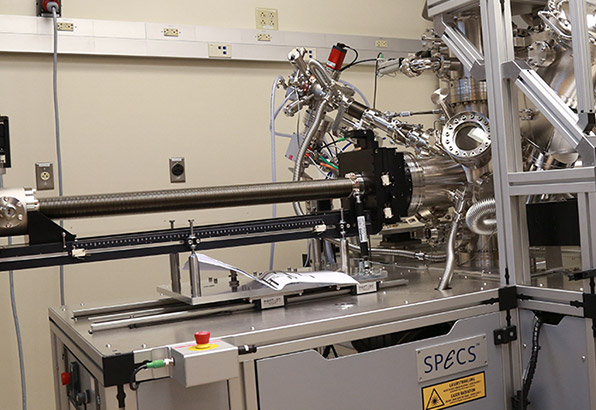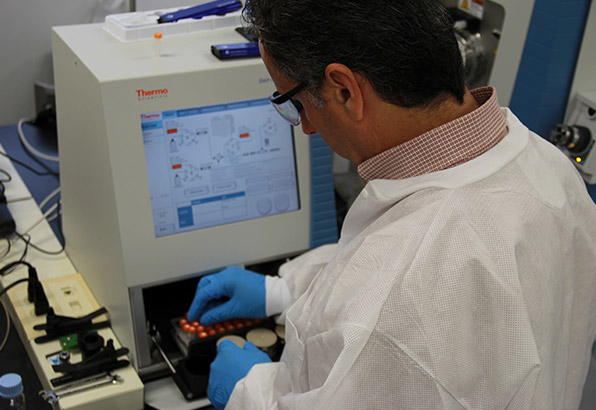2018: The Year In Review
2018: The Year In Review
As our Center aligns under a new command with a new name, take a glance at our final year as U.S. Army Research, Development and Engineering Command Edgewood Chemical Biological Center.
JANUARY | Moore Assumes Responsibilities of Director During Ceremony
Eric L. Moore, Ph.D., was formally recognized as the director of the U.S. Army Edgewood Chemical Biological Center (ECBC) during an assumption of responsibility ceremony at the Center. During the ceremony, Moore discussed his vision for the future of RDECOM ECBC and alignment with the Army’s three main priorities: readiness, modernization and reform. “We need to envision what the future will look like and partner effectively with our (chemical and biological defense) stakeholders, academia, and industry to develop technologies that give our warfighters the competitive advantage,” Moore said. “We have to ensure that we’re growing the talent and infrastructure to support tomorrow’s fight,” he continued. “We have to make sure that we’re putting the right business processes in place to deliver quality products and services to tomorrow’s warfighter. And we have to collaborate with one another to deliver tomorrow’s technology using common platforms.”
FEBRUARY | RDECOM ECBC Division Earns Department of the Army Safety Award
The Chemical Biological Test Division of RDECOM ECBC’s Engineering Directorate earned the Director of Army Safety Risk Management Award, a prestigious award presented by Brig. Gen. David Francis, commanding general of the Combat Readiness Center and director of Army Safety. “The work this team does is exponentially dangerous, and it is directly applicable to what we’re going to face in the future,” Francis said. “This team took the initiative and showed the leadership to take their own time and find ways to make their work safer. Their work is commendable and will improve both safety and readiness in the future.”
MARCH | RDECOM ECBC Employees Honored at 2018 NMTC Visionary Awards
Alena Calm and Michael Simini, Ph.D., were honored for their commitment to community involvement and STEM outreach at the 2018 Northeastern Maryland Technology Council’s (NMTC) Visionary Awards for STEM Education and Technology & Innovation Advancement. A prestigious award in the region, the NMTC Visionary Awards recognize those who contribute to building a STEM-educated workforce, advancing technology, and innovation. Calm won the NMTC’s innovator award, which recognizes “exceptional personal efforts in development and implementation of innovative program(s) measurably benefiting building our STEM-educated workforce.” Simini won the NMTC’s mentor award, which goes to someone who is “consistently volunteering their knowledge, experiences, and wisdom by going above and beyond in using their personal time and resources simply for the love of stimulating and inspiring greatness in students or teachers or organization proteges.”
MARCH | RDECOM ECBC Demolitions Begin with Amos A. Fries Research Laboratory
A decade-long initiative to remediate and demolish old buildings at RDECOM ECBC began with the remediation of the 50-year-old Amos A. Fries Research Laboratory, Bldg. E3300 in March. RDECOM ECBC’s Chemical Biological Application and Risk Reduction (CBARR) unit is conducting the clean-up effort. “This demolition puts us on the right path to addressing our responsibility to the legacy buildings and our mission at Edgewood,” said Col. Robert Phillips, Aberdeen Proving Ground’s garrison commander. “It’s reassuring to know that the people doing this have a proven track record of responsible and safe remediation and demolition. With their level of experience, CBARR is the right team for the job.”
MARCH | Decontamination Technology Awaits Field Tests
A sprayable decontamination slurry, developed by scientists at the U.S. Army Edgewood Chemical Biological Center (ECBC), is a highly effective decontaminant, working through multiple mechanisms: hydrolysis and oxidation. The slurry is designed for material decontamination of equipment and vehicles – like the fender of a Humvee – but not skin. When deployed, the decontamination slurry provides a more efficient and effective decontamination for vehicles and equipment on the battlefield. Designed for immediate, material decontamination, the decon slurry can be used immediately after a vehicle is contaminated with chemical warfare agent. After getting to safety, Soldiers can mix up the decontaminant slurry, spray it on the vehicle, and return to base.
MARCH | RDECOM ECBC Research Could Lead to Self-Decontaminating Combat Uniform
Research being conducted at ECBC is exploring whether chemical weapon-neutralizing substances can be incorporated into equipment worn by warfighters. Researchers are determining how to incorporate MOFs into fabrics and textiles to give decontamination capabilities to materials. When exposed to light, these MOFs react with and excite oxygen. In turn, oxygen reacts with and combines with agent, effectively neutralizing the threat. While there are thousands of different MOFs, ECBC researchers have identified fewer than 10 with this capability. Composed of metal ions and organic compounds, MOFs take the form of powder which could be infused with fabrics and textiles. The Defense Threat Reduction Agency (DTRA) has funded a program focused on up-scaling the production MOF materials.
MARCH | RDECOM ECBC Research Could Lead to Self-Decontaminating Combat Uniform
U.S. Army Research, Development and Engineering Command Edgewood Chemical Biological Center (RDECOM ECBC) multimedia specialist, Don Lail, spoke to a group at Towson University on mixed reality and the possibilities presented by augmented reality (AR) and virtual reality (VR) software and hardware on the future of learning. RDECOM ECBC has created AR and VR training tools that aid Soldiers in learning new, technically complex tasks such as how to safely and effectively perform sensitive site assessment in a potentially dangerous environment.
MAY | RDECOM ECBC Researchers Combine Wearable Sensors, Advanced Mass Spectrometry to Gather Life-Saving Information
Research chemist Bruce King, Ph.D., leads a team at RDECOM ECBC that is combining wearable chemical samplers and multi-dimensional chromatography to enhance Soldier protection by accurately identifying which and how much chemical warfare agent a Soldier has been exposed to. The wearable sampler clips on to a Soldier’s uniform and collects information about various substances that the Soldier may have been exposed to during a mission, collecting almost everything it encounters.
JUNE | RDECOM ECBC Integrated Early Warning at MSSPIX
The Deep Purple automated drone and the onboard chemical and biological detection system called the Array Configurable of Remote Network Sensors (ACORN) were tested in the field at Fort Leonard Wood, MO. The tests were held during the Maneuver Support Sustainment Protection Integration Experiment (MSSPIX). RDECOM ECBC scientists and engineers demonstrated the pairing’s ability to remotely navigate to a potential chemical biological threat, interrogate the threat and deliver findings back to the Soldiers in real time. Throughout 2018 Deep Purple and ACORNS were showcased at many trade shows and expos including the National Defense Industrial Association’s CBRNE conference.
JUNE | RDECOM ECBC Advises First Responders in Wake of Volcanic Eruption
In the aftermath of the Hawaiian volcano, Kilauea, eruption, scientists at RDECOM ECBC provided their expertise to help safeguard the health of first responders. The volcano’s continued eruption cast ash and chemicals into the air, posing a health concern for first responders. With a history of developing chemical and biological equipment to protect warfighters, RDECOM ECBC experts were needed to analyze and give feedback to first responders who were using protective masks. Both the National Guard and U.S. Navy looked to the Center’s experts for assurance that the masks could handle what they were facing, sulfur dioxide, hydrogen sulfide, and hydrochloric acid. Greg Peterson, Ph.D. was the point of contact at the Center for the National Guard and Navy. “The masks performed well and were built to handle much higher concentrations of contaminants. The masks were well-equipped to serve the needs of the responders.”
JULY | RAMP MD Extends RDECOM ECBC Partnership to 2023
On its fourth anniversary, the Regional Additive Manufacturing Partnership of Maryland (RAMP MD) extended its partnership with RDECOM ECBC. The two organizations agreed to a five-year extension through July 25, 2023.The amendment allows the Center to continue to be an important partner in the advancement of additive manufacturing capabilities within Maryland. “RAMP MD is an opportunity to push new, innovative technologies forward and to develop a sector of professional partners that we’ll have outreach to in the future,” Eric L. Moore, Ph.D. said. “By having commercial success, they will develop beyond our initial interactions.”
AUGUST | Saliva Samples Provide Gauge for Warfighter Readiness
Research at the U.S. Army Research, Development, and Engineering Command Chemical & Biological (RDECOM C&B) Center has scientists interested in saliva. Research biologist Trevor Glaros, Ph.D. and research biologist Elizabeth Dhummakupt, Ph.D. are heading the Center’s effort for discovering more about what information saliva has to offer the Army. Samples of Soldiers saliva might have implications for evaluating human performance and warfighter readiness. By isolating and analyzing certain biomarkers found in saliva, scientists can determine a warfighter’s physical condition and determine whether to pull him out of combat or to extend the recovery time before re-engaging. After refining the process and identifying key biomarkers, Glaros and Dhummakupt hope to develop an assay, which could function similarly to a pregnancy test, which could work in the field.
AUGUST | Handheld Genomic Sequencer Shows Promise in Field Demo
The MinION, a handheld genomic sequencer capable of detecting known and unknown biothreats including emerging and genetically modified pathogens, is being researched by the Defense Threat Reduction Agency at RDECOM ECBC. Recent breakthroughs have enabled the MinION to analyze a sample in an hour, without high-powered lab equipment, even in low resource environments.The MinION was used in West Africa during the Ebola outbreak, in Antarctica, and even on the International Space Station. Oxford Nanopore, inventors of the MinION have released a newer version that provides fully automated sequencing.
AUGUST | RDECOM ECBC Hall of Fame Opens with Two Inductees
James Baker, Ph.D., and Harry Salem, Ph.D., were inducted into RDECOM ECBC’s Hall of Fame during a ceremony held at RDECOM ECBC in August. “Both of these men represent the best of RDECOM ECBC,” said Center Director Eric Moore, Ph.D. “They contributed to making RECOM ECBC what it is today, and I am privileged to lead it. I stand on the shoulders of giants.” The Hall of Fame will be located in the waiting area of E3400 and is currently in development. Each year moving forward, one new person will be inducted into the hall of fame.
AUGUST | Science Teachers Work Alongside Army Researchers to Hone Laboratory Skills
RDECOM ECBC hosted a group of high school teachers during a two-week STEM-intensive program funded by the Defense Threat Reduction Agency (DTRA). Teachers were taken out of the classroom and into the labs for the opportunity to experience real-world laboratory science and gain practical knowledge to apply to lessons in their classrooms. Six teachers from around the country worked side-by-side with research scientists at the Center on a variety of experiments such as aerosol detection, biological sample collection and mass spectroscopy.
SEPTEMBER | Porton Man Does the Dirty Work
An international partnership with the United Kingdom has brought a new chemical and biological protective suit testing capability to the U.S. Department of Defense, with RDECOM ECBC scientists leading the effort. The partnership with the U.K.’s Defence Science and Technology Laboratory (Dstl) is part of a larger effort to share information for the good of the bilateral chemical and biological defense community and the warfighter, expanding knowledge and capabilities for both nations. The partnership with the Dstl makes available a new way to test using high tech mannequins and live chemical warfare agent. Porton Man is a carbon fiber, fully-articulated mannequin used to test the effectiveness of chemical and biological protective suit systems.
OCTOBER | Groundbreaking Research Shows Potential to Detect Opioid Exposure
Researchers at RDECOM ECBC are setting a new course for toxicology research relating to opioids, with new findings demonstrating the potential to detect low-level opioid exposure. By looking at biomarkers in blood, scientists may be able to diagnose low-level opioid exposure as long as two weeks after the event. “This is unprecedented research that lays a strong foundation for future work in opioid exposure detection and medical responses to that exposure,” Glaros said. “As opioids continue to post a significant threat domestically and on the battlefield, this research is a game changer that will help keep people safer and potentially save lives.”
OCTOBER | RDECOM ECBC Expands Capability for Agent-Surface Analysis
New to the Center’s capabilities, the NAP-XPS is a custom designed multisystem leveraged by RDECOM ECBC researchers to study and develop cutting edge materials integral to defense technologies including surface coatings, filters and textiles that will better protect the warfighter from chemical threats. The multisystem will be used to investigate the interaction of chemical warfare agents with the surface of protective materials at the molecular level. Center researchers will use the system to analyze emerging filtration and decontamination materials such as zirconium hydroxide and metal organic frameworks, gaining understanding how chemical warfare agents and battlefield contaminants interact with materials of interest.
NOVEMBER | Moore, Local Leaders Discuss Future at Army Alliance Breakfast
Local military and civilian leaders came together to discuss the future during the Army Alliance’s annual breakfast. Director Eric Moore, Ph.D., took part in a panel of local leaders on the future of the defense community in the Edgewood community. Titled, “Shaping the Future: Growing the Edgewood Defense Community,” the discussion centered on how the Army Alliance could develop the defense community, and how various government, educational and private sector institutions can collaborate to achieve that vision. Moore, along with Col. Rob Phillips, both talked about the Army’s organizational change, re-aligning RDECOM ECBC under the U.S. Army Futures Command. “What’s going on with the Futures Command is huge, and we know we’re a hub of innovation,” Phillips said. “We’re in a good position here.”
DECEMBER | RDECOM ECBC Highlights Technology Transfer Efforts to Stakeholders
The Center’s Office of Research and Technology Application (ORTA) plays a critical role in coordinating transfer of impactful technologies to and from partner organizations. When Army technology is identified as one capable of use beyond military applications, steps are taken to transfer the technology to other industry, academia, or other government agencies. As a federal laboratory, RDECOM ECBC has the authority to transfer technology in this way. Through patent license agreements, cooperative research and development agreements and technology service agreements, partnerships and collaborative efforts are established.


